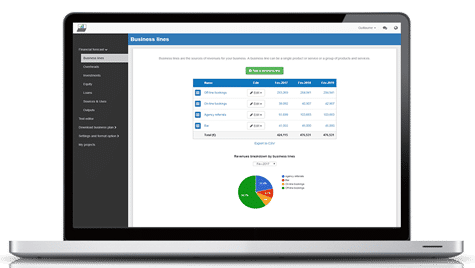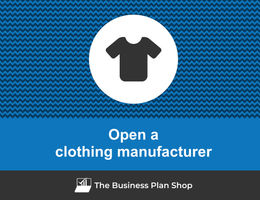How to create a financial forecast for a clothing manufacturer?
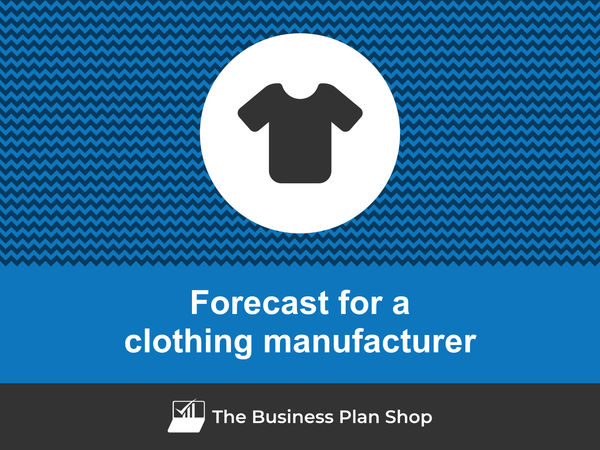
If you are serious about keeping visibility on your future cash flows, then you need to build and maintain a financial forecast for your clothing manufacturing business.
Putting together a clothing manufacturing business financial forecast may sound complex, but don’t worry, with the right tool, it’s easier than it looks, and The Business Plan Shop is here to guide you.
In this practical guide, we'll cover everything you need to know about building financial projections for your clothing manufacturing business.
We will start by looking at why they are key, what information is needed, what a forecast looks like once completed, and what solutions you can use to create yours.
Let's dive in!
Why create and maintain a financial forecast for a clothing manufacturing business?
The financial projections for your clothing manufacturing business act as a financial blueprint to guide its growth with confidence and ensure its long-term financial viability.
To create them, you will need to look at your business in detail - from sales to operating costs and investments - to assess how much profit it can generate in the years to come and what will be the associated cash flows.
During challenging market conditions, maintaining an up-to-date financial forecast enables early detection of potential financial shortfalls, allowing for timely adjustments or securing financing before facing a cash crisis.
Your clothing manufacturing business's financial forecast will also prove invaluable when seeking financing. Banks and investors will undoubtedly request a thorough examination of your financial figures, making precision and presentation essential.
Need a solid financial forecast?
The Business Plan Shop does the maths for you. Simply enter your revenues, costs and investments. Click save and our online tool builds a three-way forecast for you instantly.
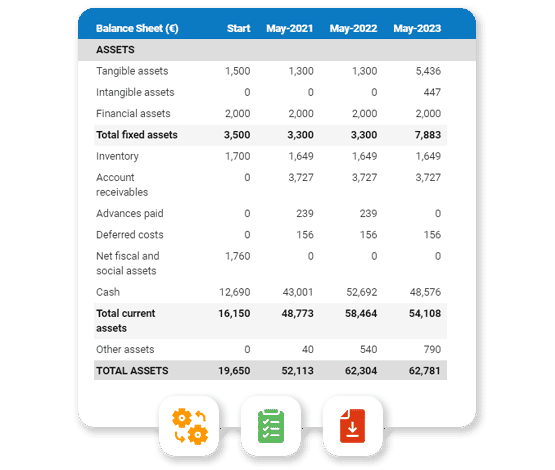
What information is needed to build a clothing manufacturing business financial forecast?
The quality of your inputs is key when it comes to financial modelling: no matter how good the model is, if your inputs are off, so will the forecast.
If you are building a financial plan to start a clothing manufacturing business, you will need to have done your market research and have a clear picture of your sales and marketing strategies so that you can project revenues with confidence.
You will also need to have a clear idea of what resources will be required to operate the clothing manufacturing business on a daily basis, and to have done your research with regard to the equipment needed to launch your venture (see further down this guide).
If you are creating a financial forecast of an existing clothing manufacturing business, things are usually simpler as you will be able to use your historical accounting data as a budgeting base, and complement that with your team’s view on what lies ahead for the years to come.
Let's now zoom in on what will go in your clothing manufacturing business's financial forecast.
The sales forecast for a clothing manufacturing business
From experience, it usually makes sense to start your clothing manufacturing business's financial projection with the revenues forecast.
The inputs used to forecast your sales will include the historical trading data of your clothing manufacturing business (which can be used as a starting point for existing businesses) and the data collected in your market research (which both new ventures and existing businesses need to project their sales forward).
Your clothing manufacturing business's sales forecast can be broken down into two key estimates:
- The average price
- The number of monthly transactions
To assess these variables accurately, you will need to consider the following factors:
- Expected changes in fashion trends may affect the demand for your clothing products, resulting in fluctuations in your average price and number of monthly transactions.
- The availability of raw materials may impact the production cost of your clothing items, which in turn may influence your average price and number of monthly transactions.
- Economic conditions, such as changes in consumer spending habits or fluctuations in currency exchange rates, can impact your average price and number of monthly transactions.
- The introduction of new technology or manufacturing processes may improve the efficiency of your production, leading to lower costs and potentially lower average prices.
- The political climate, such as changes in trade policies or tariffs, may affect the cost of importing materials or exporting products, which can impact your average price and number of monthly transactions.
Once you have a sales forecast in place, the next step will be to work on your overhead budget. Let’s have a look at that now.
Need inspiration for your business plan?
The Business Plan Shop has dozens of business plan templates that you can use to get a clear idea of what a complete business plan looks like.

The operating expenses for a clothing manufacturing business
The next step is to estimate the expenses needed to run your clothing manufacturing business on a day-to-day basis.
These will vary based on the level of sales expected, and the location and size of your business.
But your clothing manufacturing business's operating expenses should include the following items at a minimum:
- Staff Costs: This includes salaries, benefits, and any other expenses related to hiring and managing employees such as training and development costs.
- Raw Materials: This includes the cost of purchasing materials such as fabric, thread, buttons, and zippers for manufacturing clothing.
- Equipment Maintenance: As a clothing manufacturing business, you will need to regularly maintain and repair your sewing machines, cutting tables, and other equipment to ensure smooth operations.
- Rent: If you are operating out of a physical location, you will need to account for the monthly rent or lease payments for your manufacturing facility.
- Utilities: This includes the cost of electricity, water, and other utilities needed to run your manufacturing facility.
- Marketing and Advertising: To promote your clothing brand and attract customers, you may need to allocate funds for marketing and advertising campaigns.
- Packaging and Shipping: You will need to factor in the cost of packaging materials and shipping fees when selling your clothing products to customers.
- Accountancy Fees: To ensure accurate financial records and tax compliance, you may need to hire an accountant or use accounting software which may come with a subscription fee.
- Insurance Costs: You will need to consider the cost of insurance to protect your business from potential risks such as theft, fire, and liability claims.
- Software Licenses: As a clothing manufacturing business, you may use software for inventory management, design, or production planning which may require a monthly or annual subscription fee.
- Banking Fees: This includes fees associated with business bank accounts, credit card processing, and other financial transactions.
- Legal Fees: You may need to hire a lawyer to assist with drafting contracts, protecting your intellectual property, or handling any legal disputes that may arise.
- Professional Services: This could include consulting fees for business development, HR services, or hiring a fashion designer to create new clothing designs.
- Office Supplies: You will need to purchase office supplies such as paper, ink, and pens to support day-to-day operations in your manufacturing facility.
- Travel and Entertainment: If you attend trade shows, visit suppliers, or meet with potential clients, you will need to budget for travel and entertainment expenses.
This list is, of course, not exhaustive, and you'll have to adapt it according to your precise business model and size. A small clothing manufacturing business might not have the same level of expenditure as a larger one, for example.
What investments are needed to start or grow a clothing manufacturing business?
Once you have an idea of how much sales you could achieve and what it will cost to run your clothing manufacturing business, it is time to look into the equipment required to launch or expand the activity.
For a clothing manufacturing business, capital expenditures and initial working capital items could include:
- Machinery and Equipment: This includes items such as sewing machines, cutting tables, and pressing equipment. These are essential for the production process and can be a significant capital expenditure for a clothing manufacturing business.
- Inventory: This includes the raw materials and fabrics that are used to create the clothing items. The cost of purchasing these materials can be a significant capital expenditure, especially for larger orders.
- Factory or Production Space: This refers to the physical location where the clothing items are manufactured. The cost of purchasing or leasing this space can be a significant capital expenditure for a clothing manufacturing business.
- Transportation Vehicles: If the clothing manufacturing business needs to transport materials or finished products, investing in transportation vehicles such as trucks or vans may be necessary. This can be a significant capital expenditure, especially for larger businesses.
- Technology and Software: In today's digital age, investing in technology and software is crucial for a clothing manufacturing business. This includes software for design and pattern making, as well as hardware such as computers and printers. These can be significant capital expenditures for a business.
Again, this list will need to be adjusted according to the specificities of your clothing manufacturing business.
Need a convincing business plan?
The Business Plan Shop makes it easy to create a financial forecast to assess the potential profitability of your projects, and write a business plan that’ll wow investors.
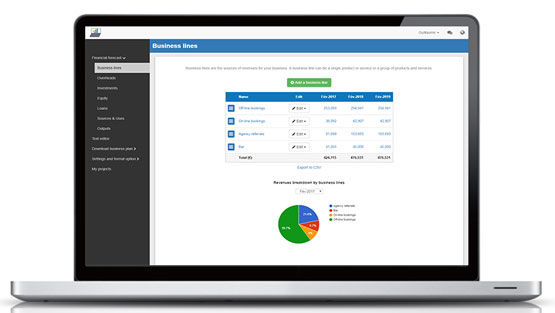
The financing plan of your clothing manufacturing business
The next step in the creation of your financial forecast for your clothing manufacturing business is to think about how you might finance your business.
You will have to assess how much capital will come from shareholders (equity) and how much can be secured through banks.
Bank loans will have to be modelled so that you can separate the interest expenses from the repayments of principal, and include all this data in your forecast.
Issuing share capital and obtaining a bank loan are two of the most common ways that entrepreneurs finance their businesses.
What tables compose the financial plan for a clothing manufacturing business?
Now let's have a look at the main output tables of your clothing manufacturing business's financial forecast.
The projected profit & loss statement
The projected profit & loss shows how profitable your clothing manufacturing business is likely to be in the years to come.

For your clothing manufacturing business to be financially viable, your projected P&L should ideally show:
- Sales growing above inflation (the higher the better)
- Profit margins which are stable or expanding (the higher the better)
- A net profit at the end of each financial year (the higher the better)
This is for established clothing manufacturers, there is some leniency for startups which will have numbers that will look a bit different than existing businesses.
The projected balance sheet
Your clothing manufacturing business's forecasted balance sheet enables you to assess your financial structure and working capital requirements.
It is composed of three types of elements: assets, liabilities and equity:
- Assets: represent what the business owns and uses to produce cash flows. It includes resources such as cash, equipment, and accounts receivable (money owed by clients).
- Liabilities: represent funds advanced to the business by lenders and other creditors. It includes items such as accounts payable (money owed to suppliers), taxes due and loans.
- Equity: is the combination of what has been invested by the business owners and the cumulative profits and losses generated by the business to date (which are called retained earnings). Equity is a proxy for the value of the owner's stake in the business.

The cash flow projection
The cash flow forecast of your clothing manufacturing business will show how much cash the business is expected to generate or consume over the next three to five years.

There are multiple ways of presenting a cash flow forecast but from experience, it is better to organise it by nature in order to clearly show these elements:
- Operating cash flow: how much cash is generated by the clothing manufacturing business's operations
- Investing cash flow: what is the business investing to expand or maintain its equipment
- Financing cash flow: is the business raising additional funds or repaying financiers (debt repayment, dividends)
Your cash flow forecast is the most important element of your overall financial projection and that’s where you should focus your attention to ensure that your clothing manufacturing business is adequately funded.
Note: if you are preparing a financial forecast in order to try to secure funding, you will need to include both a yearly and monthly cash flow forecast in your clothing manufacturing business's financial plan.
Need a solid financial forecast?
The Business Plan Shop does the maths for you. Simply enter your revenues, costs and investments. Click save and our online tool builds a three-way forecast for you instantly.

Which tool should you use to create your clothing manufacturing business's financial forecast?
Using the right tool or solution will make the creation of your clothing manufacturing business's financial forecast much easier than it sounds. Let’s explore the main options.
Using online financial projection software to build your clothing manufacturing business's forecast
The modern and easiest way to build a forecast is to use professional financial projection software such as the one we offer at The Business Plan Shop.
There are several advantages to using specialised software:
- You can easily create your financial forecast by letting the software take care of the financial calculations for you without errors
- You have access to complete financial forecast templates
- You get a complete financial forecast ready to be sent to your bank or investors
- You can easily track your actual financial performance against your financial forecast, and recalibrate your forecast as the year goes by
- You can create scenarios to stress test your forecast's main assumptions
- You can easily update your forecast as time goes by to maintain visibility on future cash flows
- You have a friendly support team on standby to assist you when you are stuck
- It’s cost-efficient and much cheaper than using an accountant or consultant (see below)
If you are interested in this type of solution, you can try our forecasting software for free by signing up here.
Calling in a financial consultant or chartered accountant
Enlisting the help of a consultant or accountant is also a good way to obtain a professional clothing manufacturing business financial forecast.
The downside of this solution is its cost. From experience, obtaining a simple financial forecast over three years (including a balance sheet, income statement, and cash flow statement) is likely to cost a minimum of £700 or $1,000.
The indicative cost above, is for a small business, and a forecast is done as a one-shot exercise. Using a consultant or accountant to track your actuals vs. forecast and to keep your financial projections up to date on a monthly or quarterly basis will cost a lot more.
If you opt for this solution, make sure your accountant has in-depth knowledge of your industry, so that they may challenge your figures and offer insights (as opposed to just taking your assumptions at face value to create the forecast).
Why not use a spreadsheet such as Excel or Google Sheets to build your clothing manufacturing business's financial forecast?
Creating an accurate and error-free clothing manufacturing business financial forecast on Excel (or any spreadsheet) is very technical and requires both a strong grasp of accounting principles and solid skills in financial modelling.
Most entrepreneurs lack the expertise required to create an accurate financial forecast using spreadsheet software like Excel or Google Sheets. As a result, it is unlikely anyone will trust your numbers.
The second reason is that it is inefficient. Building forecasts on spreadsheets was the only option in the 1990s and early 2000s, nowadays technology has advanced and software can do it much faster and much more accurately.
This is why professional forecasters all use software. With the rise of AI, software is also becoming smarter at helping us detect mistakes in our forecasts and helping us analyse the numbers to make better decisions.
Finally, like everything with spreadsheets, tracking actuals vs. forecasts and updating your forecast as the year progresses is manual, tedious, error-prone, and time-consuming. Whereas financial forecasting software like The Business Plan Shop is built for this.
Need a convincing business plan?
The Business Plan Shop makes it easy to create a financial forecast to assess the potential profitability of your projects, and write a business plan that’ll wow investors.

Use our financial projection templates for inspiration
The Business Plan Shop has dozens of financial forecast templates available.
Our examples contain a complete business plan with a financial forecast and a written presentation of the company, the team, the strategy, and the medium-term objectives.
Whether you are just starting out or already have your own clothing manufacturing business, looking at our financial forecast template is a good way to:
- Understand what a complete business plan should look like
- Understand how you should model financial items for your clothing manufacturing business
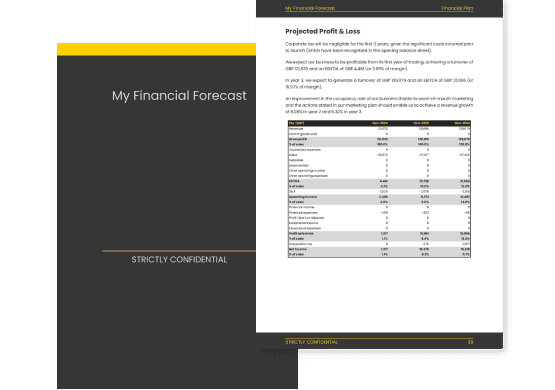
Takeaways
- A financial projection shows expected growth, profitability, and cash generation for your business over the next three to five years.
- Tracking actuals vs. forecast and keeping your financial forecast up-to-date is the only way to maintain visibility on future cash flows.
- Using financial forecasting software makes it easy to create and maintain up-to-date projections for your clothing manufacturing business.
You have reached the end of our guide. We hope you now have a better understanding of how to create a financial forecast for a clothing manufacturing business. Don't hesitate to contact our team if you have any questions or want to share your experience building forecasts!
Need inspiration for your business plan?
The Business Plan Shop has dozens of business plan templates that you can use to get a clear idea of what a complete business plan looks like.

Also on The Business Plan Shop
Know someone who runs or wants to start a clothing manufacturing business? Share our financial projection guide with them!

